Seeking to understand and be understood

In the beginning community of three-, four-, five-, and six-year-olds, the teachers hope to cultivate courageous thinkers, collaborators, and change makers. We want the children to know — as we do — that their ideas, theories and stories can change the world. This year, the big idea that the children and adults are co-researching in the preschool classrooms is transformation related to the self and others, the arts and sciences, and the natural world. We’re investigating a set of guiding questions, including this one:
How might the process of creating, imagining, or inventing support the children’s sense of purpose and belonging in a community?
Loris Malaguzzi reminds us that when we enter the classroom, we carry with us pieces from our lives — our ideas, experiences and stories. At school, there is no separation from our life outside of it. So, we invite each others’ stories into the classroom to vitalize our relationships.
Ralph Fletcher said, “When we say old friend what we really mean is I know your story and you know my story.” We know that stories have the power to influence our community, and they are the heartbeat of our work. Stories connect us, and help us make meaning of the world. In our learning community, they become critical reference and reflection points.
This story from the Cedar community is an example of how playing with friends and the natural world supports the children to make meaning of their experiences – meaning that children are eager to capture and share as they seek to understand and be understood.
The children visit Outdoor Adventure a couple of times each week. For the first two months of school, there was water in a fountain. When the water was turned off for the winter, and the children were confused. In response, Arlo quickly generated a theory: The water was hidden under a flat rock.
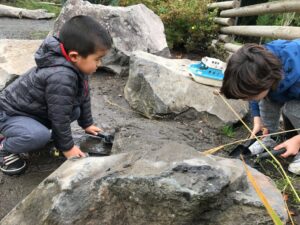
To test this idea, he needed to move the big, heavy rock. He recruited a friend, Isaac, and they worked together trying to pry the rock with plastic shovels. It didn’t budge. But Arlo and Isaac didn’t give up. This idea of moving the flat rock to find hidden water was too compelling.
Arlo is a child who is most alive when he’s outside, his stories seem more vivid and his connections more vibrant. In the natural world, he knows so much about how to move things, how to break things, and the relationship among things.
Arlo’s strong voice bellowed, “Everyone lift it up! The water is beneath it!” In this moment, he did what he’s done so many times before: He turned to his community, his friends, who reliably support him when he bumps into a problem.
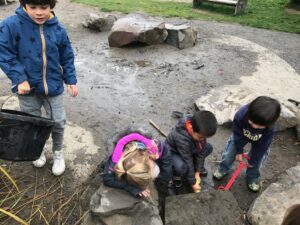
He circled the area and rounded up more helpers. He felt excited about his idea, and his friends felt excited too. Soon, the other children were moving toward the rock, buzzing with anticipation, hooked on Arlo’s theory about trapped water, and eager to find it living beneath the slate.
He brought them into his idea, he brought them into his world where he believes anything is possible with his community by his side. Arlo and his friends worked together to poke and prod. They were curious and committed. They took swift action: They tried wedging their shovels under the rock’s edge, they tried dumping loose rocks on top for magic, they broke many sticks in their attempts to access the water underneath but it didn’t slow them down. They kept building their thinking together. They were deeply invested in their play.
Here’s a slice of their dialogue:
Arlo: We need everyone to help! Help us move this rock, we need to see the water!
Everly: I’ll try!
Isaac: Use your shovels!
Arlo: We need to put dirt on it!
Everly: My whole body is really tired out!
Belle: Somebody lift it!
Megan: This feels like friendship and hard work.
Pearl: I have energy, so I can help!
Arlo: Let’s try sticks!
It didn’t work. Then, Arlo had a new idea. He suggested that everyone could push a big rock from the top of the hill. He predicted it would roll fast and smash the flat rock, and then they could get to the water. His friends were excited and wanted to give it a go.
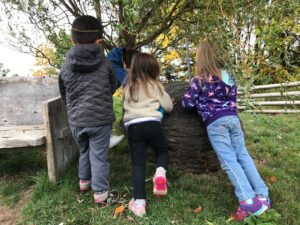
After pushing and pushing, Everly said, “Did you know this is called a boulder? If it’s a boulder we can’t move it.”
But Arlo didn’t give up. “Come on!” he said, “Help me bang the rock so we can see if it will roll down! We can do it with teamwork!”
This idea of teamwork is foundational to their play together. It came up spontaneously on another day, with another group of children playing with magnatiles.
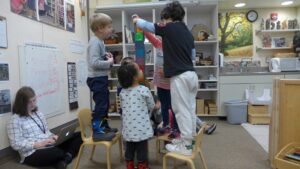
Alex: What are you making?
Isaac: A tower that is eight feet.
Alex: I will get some chairs when we need it.
Brooklyn: Do you need some feet? I know how to make some feet.
Alex: No no no no no we are trying to build a tall tower eight feet.
Brooklyn: It’s wobbling, I’ll hold it, do you want me to hold it, ‘cuz it’s wobbling?
Alex: I’ll stand on this chair waiting for if it is really tall. I’ll wait and see if you need any tall support.
Isaac: Then just take a nap, William!
Alex: I’ll do the tall support now!
Brooklyn: We are doing teamwork! This is teamwork!
Alex: We are doing teamwork! We are doing collaboration!
Belle: But what does collaboration mean?
Alex: When we are all working together!
Isaac: This is super-tall! It’s taller than me!
Everly: Does anyone need help building?
Alex + Isaac: Yeah, we need help!
Back at Outdoor Adventure, Arlo and his friends were fully engaged in the experience because they care deeply about each other, and that care propels them to want to explore what’s possible in a seemingly impossible situation.
Despite their tremendous effort, as you might imagine, the boulder didn’t budge. But, ultimately, that’s not what stuck with them. Instead, it’s the powerful sense of joy in the midst of this massive challenge that they remember. These children, like Arlo, know that they can ask for help and offer help. They know they can find joy even when the outcome falls short of their goal. They know that ultimately, it’s their effort that matters most.
The children still care a lot about this story of water living under the flat rock. To this day, when they’re in Outdoor Adventure, they continue to grab shovels and sticks and try to lift it, because Arlo’s theory continues to tickle their imaginations. They’ve made his idea part of their own. Now, Arlo’s curiosity, courage and commitment live in his friends too. That’s the value of relationships.
Building on Arlo’s energy and engagement with the big rock, his teacher Hana wondered if Arlo might want to make a book about it. Arlo shows confidence and competence in many areas of the classroom, but he does not yet see himself as a reader or writer. These are places that he appears to feel vulnerable, challenged and not engaged.
Just as we give each other labels, like tough guy, which interrupt our ability to be in relationship with others, we label ourselves too. Arlo has no doubt that he’s a storyteller, he’s seen how his stories connect him to others, he knows how his friends crave his imagination, suspense and humor. Yet, when it comes to mark-making, it seems as though his beliefs have limited his willingness to grow his abilities.
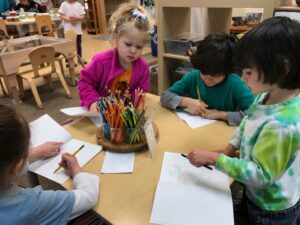
Arlo made a book. His drawings were still tentative, but we celebrated that he was willing to take a risk and work hard to retell the story. Here are his words:
We were looking for water. We decided to push the boulder and breaking the rock. It started to rain. They decided to get the shovels. The rain pushed the rock, it got covered in scratches. When the rock got covered in scratches, it broke in tiny pieces.
There’s something significant that stands out in this story: Arlo used “we” when he retold the story. This demonstrated that he knows that he’s part of something bigger than himself. In the word we, there’s no distinction between him and his community. The value for him wasn’t that it was his idea, it was that he was playing and working with his friends on a shared idea.
This story reminds me of the words of Paulo Freire:
“Reading words, and writing them, must come from the dynamic movement of reading the world. The question here is how to create a fluid continuity between on the one hand reading the world, and speaking about experience, of talking freely with spontaneity and on the other hand the moment of writing and then learning how to read, so that the words which become the starting point for learning to read and write come from the kids’ ideas and not from the teacher’s reading book.”
Dear Reader, I wonder:
What are your stories that capture the relationships between an individual and the community, vulnerability and courage, and interdependence and transformation?
